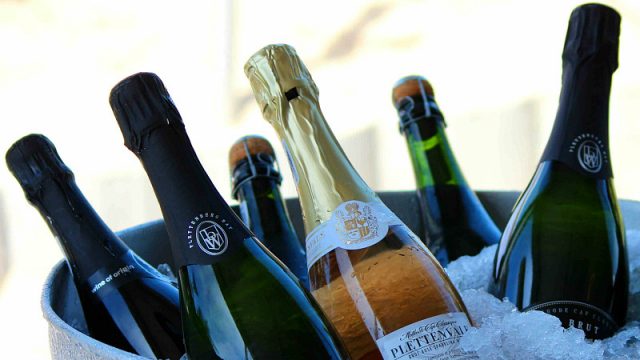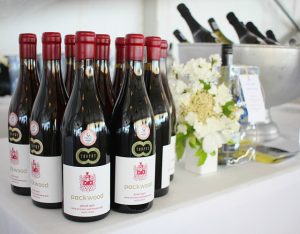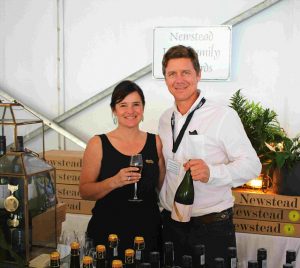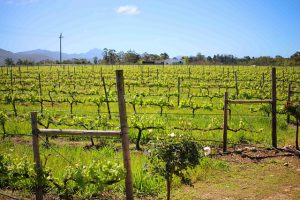If you’d told someone 15 years ago that a man and his wife had just planted a vineyard along the Garden Route, they probably would have laughed out loud. But today, Plettenberg Bay, home to scenic beaches and an opulent coastline dappled with forestry, valleys and mountain passes, is also home to 20 wine-producing vineyards.
Plettenberg Bay’s second Wine and Bubbly Festival afforded the rare occasion of having all the people who’d shaped this tall tale into a success story, together in one room, giving me the unique opportunity to learn every side of its fascinating history.
Peter and Caroline Thorpe of Bramon Wines moved to Plettenberg Bay in 1997 and bought a large farm 10 km outside Plett without thinking much about its grape-growing potential. Pete (as he’s better known) smiles as he relays the story. “I kept looking at the property and thinking ‘maybe we could make wines here’, even though there were none in the area.”
Pete grew up on a wine farm in Worcester so he trusted his niggling hunch and began researching the area, speaking to people in the know, and examining the soil conditions. It was confirmed that the area would probably be very good for white wines like Sauvignon Blanc, and early reds. “I planted the first hectare in 2000 and we had our first harvest in 2004, which I sent through to Peter Ferreira (Graham Beck Wines) to vinify as we didn’t have our own winery. He called me at one in the morning and told me it was the best Sauvignon Blanc he’d ever had in his cellar, quality-wise, and we thought ‘Okay, this is gonna work, this is brilliant!’” Pete then went on to plant further in 2004 and 2005 respectively. 2006 saw Vicky Gent of Packwood Wines joining the scene and, over the next nine years, a further 18 vineyards were started in the region.
Peter Ferreira continued to vinify Bramon’s wines until 2008 when he called Anton Smal (of Villiera Wine fame) and told him that things were really starting to happen on the Plett wine scene. Anton came out and was amazed by what he saw, but sadly there weren’t enough vineyards on board to justify his departure from Villiera. He took over the vinification of Bramon’s wines in 2009, but had to do so from Stellenbosch. In 2010 things changed with the addition of Luka, Anderson and Newstead Wines; Bramon was also able to build their own cellar and so could finally welcome Anton on as the fulltime winemaker for the four farms.
Anton, known for his dedicated and creative winemaking, and for wearing his heart on his sleeve, elaborates on the journey, “I spent over twenty years at Villiera, which is unheard of in the wine industry. Villiera has a fantastic range of white wines so I had great experience in that realm, but in Plett we were dealing with entirely virgin territory which doesn’t come without its challenges: the wildlife, nature and climate all affected the vines, but, lucky for us, Pete had done his homework before planting.”
Anton explains, “Everyone thought we were crazy and that it would never work, but the Sauvignon Blanc grapes were perfect as they love the cooler climate here. And, if there were problems with the ripening, which there were due to the summer rains, we could pick the grapes early and use them for bubbly, as you pick them at a lower sugar level, adding sugar at a later stage.” They did, and it was a resounding success, because, in Anton’s words, “Even at an unripened stage, the Sauvignon grapes already have a lovely development of fruit.”
Reflecting on the vintage Anton laughs and adds, “The 2011 was one of the most challenging vintages of my life, but then you see, the cellar magic came into play and in tasting the 2011 today – it’s simply extraordinary, just beautiful.”
They’ve also been testing the PH levels of the wines and are finding them to be exceptionally low, as are the acidity levels, “This area is also superb for maturing white wines and, because of the low PHs, these wines can live and mature for ten years. The sulphur levels are virtually non-existent…I actually want to start making a style of Sauvignon Blanc that I can lie down for six or seven years because there’s nothing quite like an eight or 10 year old Sauvignon Blanc and I think we can achieve that here.”
Indeed they’ve been reaping the rewards, or rather I should say ‘awards’, for all their hard work: Bramon and Newstead have both won double gold medals at the Michelangelo International Wine Awards for their MCCs (Bramon for their 2012 and 2013 Blanc de Blanc MCCs, and Newstead for their 2012 Brut MCC), and the list of awards for their still wines is just too long to mention.
Anton smiles as he reflects on their accomplishments, “What makes Plett unique is that we’re concentrating on small vineyards: 1 to 14½ hectares, so it’s very personal and hands-on, and that’s the beauty of it all, you adapt to nature…I’m personally amazed at the results we’ve achieved in such a short time, in such a new area.”
Vicky Gent of Packwood has very similar sentiments; she and her husband are dairy farmers who also moved to Plett in 1997. They bought a farm and started from scratch with Packwood: seeing the potential, they built a dairy in the early 2000’s and then planted the vines in 2006, “We just couldn’t understand why there was all this agriculture and no vines in this area, so we met with Pete from Bramon, went to see experts in Cape Town who came out and did the soil agronomy, and then picked the right site and planted Sauvignon, Chardonnay and Pinot Noir.”
Their original winemaker, Teddy Hall, helped them up to 2012 before encouraging them to go it on their own. They plucked up the courage, built a small winery and followed his instructions to the T, she laughs, “It’s hard work, it’s not romantic and it’s not for the faint-hearted.”
Vicky and her team have grown from strength to strength; winning silver at the International Wine & Spirit Competition for their 2012 Gent Bubbly Chardonnay/Pinot Noir blend and a Bronze for the Pinot Noir as well as a Double Gold for the Gent Bubbly Chardonnay/Pinot Noir blend and a trophy for the Pinot Noir at the Vitis Vinifera awards.
I ask Vicky what terroir she thinks Plett is most similar to, as it’s been compared to New Zealand and parts of Europe, and she smiles and replies, “I’d say it’s most similar to Plett – why do we have to be compared to somewhere else?”
I speak to all the wine farmers about what’s on the cards for them, and the response is just wonderful: Pete tells me that they’ve planted experimental blocks of Sangiovese, Malbec and Pinotage and are gearing towards a Chenin Blanc. Anton’s excited about taking a chance on some Malbec and Cabernet Franc at Redford Lane Wines, whilst continuing to explore Pinot Noir at Newstead.
He tells me that Pinot Noir has serious potential in Plett, which is why so many of the farms are planting it, but that with the cooler climate they’re going to be light and fruity rather than earthy and fuller-bodied, “You can expect more feminine Pinot Noirs, full of cherry and raspberry, not like that of burgundy…They’ll be perfect for the summer weather.”
Anton pours me another glass of wine and beams, “Every year we’re learning a little more and hopefully one day we’ll be one of the top producers in the country in terms of our quality and awards.” Pete agrees and can only add, “We’re going to continue to concentrate on quality and keeping our winefarms ‘boutique’ so that each year we have a different story for our wines.” Indeed, “There are so many stones unturned.
There are approximately 20 wine estates in the Plettenberg Bay region of South Africa, and many provide wine tasting (some by appointment only). For a list of vineyards, visit Plettwinelands.com.





